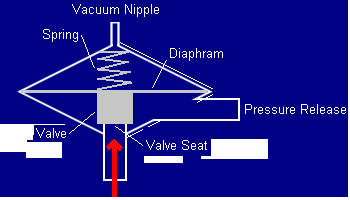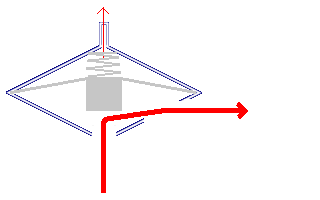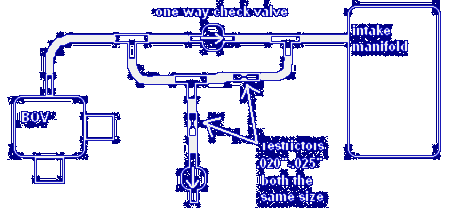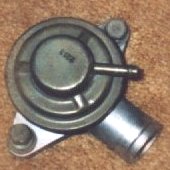
On a turbo engine, the BOV is used to relieve the pressure from the turbo output when the throttle is closed. These valves are only used on engines with the blow-through turbo setup. For more information on this, see the Turbocharger Concepts page. The BOV is basically a vacuum-actuated valve that opens when sufficient vacuum is present. Vacuum is supplied by a connection on the throttle body, while the BOV inlet is connected to the turbo output hose. On 1988 or later Chrysler Turbo I and Turbo III engines, the BOV is placed inside that airbox to suppress noise and prevent the BOV from sucking in dirty air.
While in boost, the valve remains closed and the turbo pumps air into
the engine normally. Without the BOV, when the throttle is closed
the turbo is suddenly trying to pump air against a closed throttle plate.
This creates a pressure spike in the turbo output hose and sends a pressure
"wave" crashing back and forth between the throttle plate and the turbo
compresser blades. The pressure spike quickly slows down the turbo
and the pressure wave can actually damage the turbo. On intercooled
engines, this pressure wave effect is suppressed but the pressure spike
still occurs. When the throttle is opened again, the turbo has to
spin up again, creating turbo lag. If a BOV is present, the BOV will
open as soon as the throttle is closed, releasing the pressure spike into
the airbox and avoiding the pressure wave phenomena.

The spring holds the valve closed, but if enough pressure reaches the BOV inlet, it will be forced open (about 15psi). When the throttle is closed and vacuum is supplied to the front of the BOV diaphram, it releases the pressure from the turbo:

As you can see, the operation of the BOV is fairly simple. While this diagram looks similar the the stock Chrysler BOV, there are other BOVs available that look different, but work the same.
When the throttle is opened again, the BOV will close because the quick
release valve will vent the vacuum inside the BOV. There is a
fraction of a second between when the throttle is opened and the BOV closes.
When the throttle is suddenly opened, the turbo is usually not spinning
very fast and is not providing much boost, if any. There is often
a moment where there is actually a vacuum between the throttle body and
the turbo because the turbo hasn't "caught up" with the engine's demand
for more air yet. Since the BOV is still in the process of closing,
it will often suck some air through the pressure release connection because
of this vacuum inside the turbo output hose. This is part of the
reason that the BOV is located inside the airbox on the clean side of the
filter. If some air is sucked in, it will always be clean air.
If you are installing you own BOV, be sure to either put a small filter
on the release side of the BOV, or connect it to the clean side of the
airbox.


 The
Mitsubishi BOV that was used on all Mitsubishi Eclipse, Eagle Talon, and
Plymouth Laser cars equipped with a 2.0L Turbo engine is a very high quality
BOV. It is all aluminum and has a VERY stiff spring. It will
not forced open until over 23psi! In 1995, the BOV was changed and
is of poor quality so be sure to get a pre-1995 (1st generation DSM) BOV.
They are about $95 from the dealer, or around $50-$75 from the DSM
Parts Trader. This BOV has a 1" inlet and outlet, but only has
one hose connection because it is designed to be mounted to a manifold.
It can be retrofitted for hoses, thanks to Gus Mahon. See Garry
Donovan's web page in it. His web page also has other BOV info
and shows some pictures of other, aftermarket BOVs. The Mitsubishi
BOV also has a faster response time than the stock or Bosch BOVs.
This is because of the stiff spring in conjunction with the diaphram vent.
The vent is a small tube that feeds the back of the diaphram with boost
from the outside of the valve. So when you are in boost, the pressure
is pushing on the valve and on the back of the diaphram to try and open
the valve, but the stiff spring holds it shut. When the throttle
is closed, vacuum appears on the front of the diaphram and the combination
of the vacuum on the front of the diaphram, the pressure on the back of
the diaphram, and the pressure on the valve causes it to open quickly.
Once the valve is open, the pressure from the turbo is released along with
the pressure on the back of the diaphram. Now, only the vacuum on
the front of the diaphram is holding it open. Once the throttle is
opened, the vacuum disappears and the BOV slams shut because of the stiff
spring.
The
Mitsubishi BOV that was used on all Mitsubishi Eclipse, Eagle Talon, and
Plymouth Laser cars equipped with a 2.0L Turbo engine is a very high quality
BOV. It is all aluminum and has a VERY stiff spring. It will
not forced open until over 23psi! In 1995, the BOV was changed and
is of poor quality so be sure to get a pre-1995 (1st generation DSM) BOV.
They are about $95 from the dealer, or around $50-$75 from the DSM
Parts Trader. This BOV has a 1" inlet and outlet, but only has
one hose connection because it is designed to be mounted to a manifold.
It can be retrofitted for hoses, thanks to Gus Mahon. See Garry
Donovan's web page in it. His web page also has other BOV info
and shows some pictures of other, aftermarket BOVs. The Mitsubishi
BOV also has a faster response time than the stock or Bosch BOVs.
This is because of the stiff spring in conjunction with the diaphram vent.
The vent is a small tube that feeds the back of the diaphram with boost
from the outside of the valve. So when you are in boost, the pressure
is pushing on the valve and on the back of the diaphram to try and open
the valve, but the stiff spring holds it shut. When the throttle
is closed, vacuum appears on the front of the diaphram and the combination
of the vacuum on the front of the diaphram, the pressure on the back of
the diaphram, and the pressure on the valve causes it to open quickly.
Once the valve is open, the pressure from the turbo is released along with
the pressure on the back of the diaphram. Now, only the vacuum on
the front of the diaphram is holding it open. Once the throttle is
opened, the vacuum disappears and the BOV slams shut because of the stiff
spring.
The first question is where to put the BOV. The most popular setup is to mount a hose connection somewhere on the upper intercooler ducting. If you have a stock Turbo II airbox, one idea would be to rivit and RTV a hose connection somewhere on that upper duct. You would have to grind off some of the ribs and use a hose connection with some sort of flange on it. You don't want anything protruding into the duct because it will restrict the air flow to the throttle body.
 Another
idea is to weld a hose connection on a smooth-curved piece of 2 1/4" exhaust
pipe. You can use this, along with two short pieces of 2 1/4" truck
raditator hose as the connection from the intercooler to the air box (or
right to the throttle body, if you don't have the Turbo II airbox).
You will have to cut the curved pipe such that it has the correct angle.
If you won't want to weld it, you can use pop-rivits and RTV. This
is how I did it on my 1988
Dodge Shadow ES. The picture to the right shows the pipe with
the 1" fitting rivited and RTVed on. This size is for the Talon BOV
or the Bosch BOV (I shoved the 7/8" I.D. hose on there). I cut the
fitting out of the bottom of a crankcase breather filter for a Dodge Ram
V8 (Fram BA3632 or CA3632).
Another
idea is to weld a hose connection on a smooth-curved piece of 2 1/4" exhaust
pipe. You can use this, along with two short pieces of 2 1/4" truck
raditator hose as the connection from the intercooler to the air box (or
right to the throttle body, if you don't have the Turbo II airbox).
You will have to cut the curved pipe such that it has the correct angle.
If you won't want to weld it, you can use pop-rivits and RTV. This
is how I did it on my 1988
Dodge Shadow ES. The picture to the right shows the pipe with
the 1" fitting rivited and RTVed on. This size is for the Talon BOV
or the Bosch BOV (I shoved the 7/8" I.D. hose on there). I cut the
fitting out of the bottom of a crankcase breather filter for a Dodge Ram
V8 (Fram BA3632 or CA3632).
If you have a straight run from the intercooler to the throttle body, then mount the BOV somewhere on the piping there.
No matter which way you choose, some thought and some fabrication will be necessary to do it right. Also, you need to be concerned about the pressure release side of the BOV. Make sure that you put a small filter on it, or that you connect it to the clean side of your air box. You don't want it to suck any dirt or debris into the engine.
Also keep in mind the blow-off point of the BOV you are using.
The stock Chrysler BOV will blow off (be forced open) at about 15psi.
The Bosch BOV will blow off at about 9psi, while the Mitsubishi BOV won't
blow off until about 23psi. If you are running boost levels that
are higher than the blow-off point of your BOV, then you will be leaking
boost through the BOV. You may need to supply the BOV vacuum nipple
with some boost using the design shown above.
| Return to the Mini-Mopar Turbo Performance page |
This page is maintained by Russell W. Knize and was last updated 02/09/99. Comments? Questions? Email minimopar@myrealbox.com.
Copyright © 1996-2003 Russ W. Knize